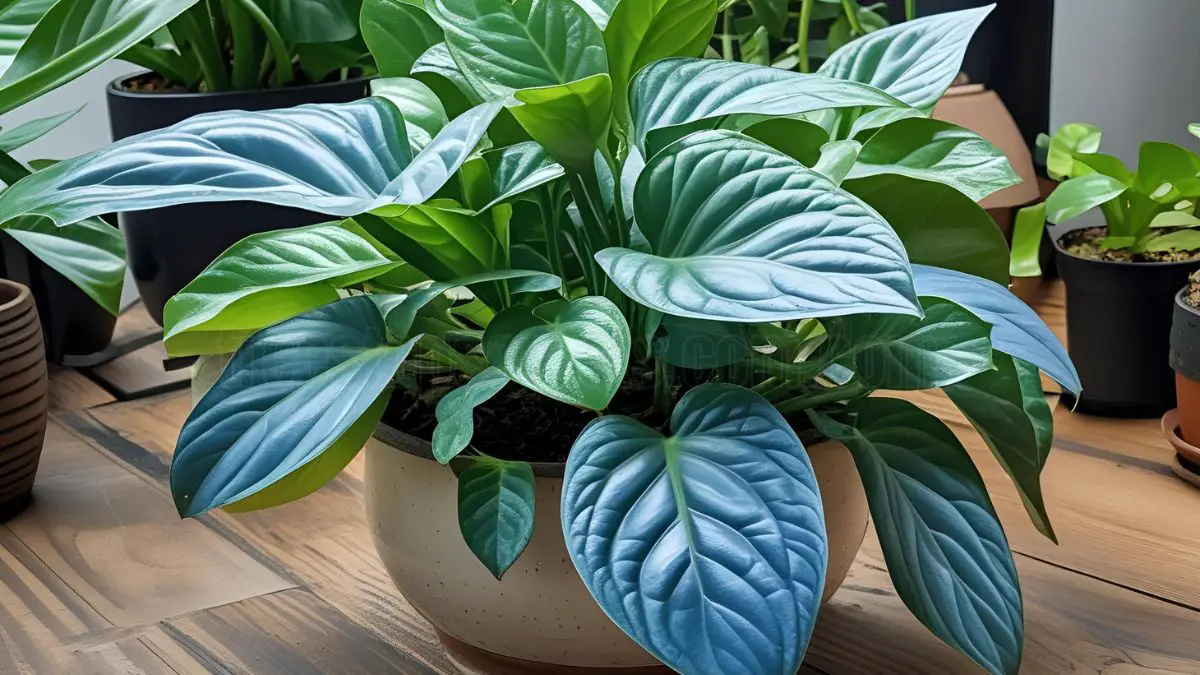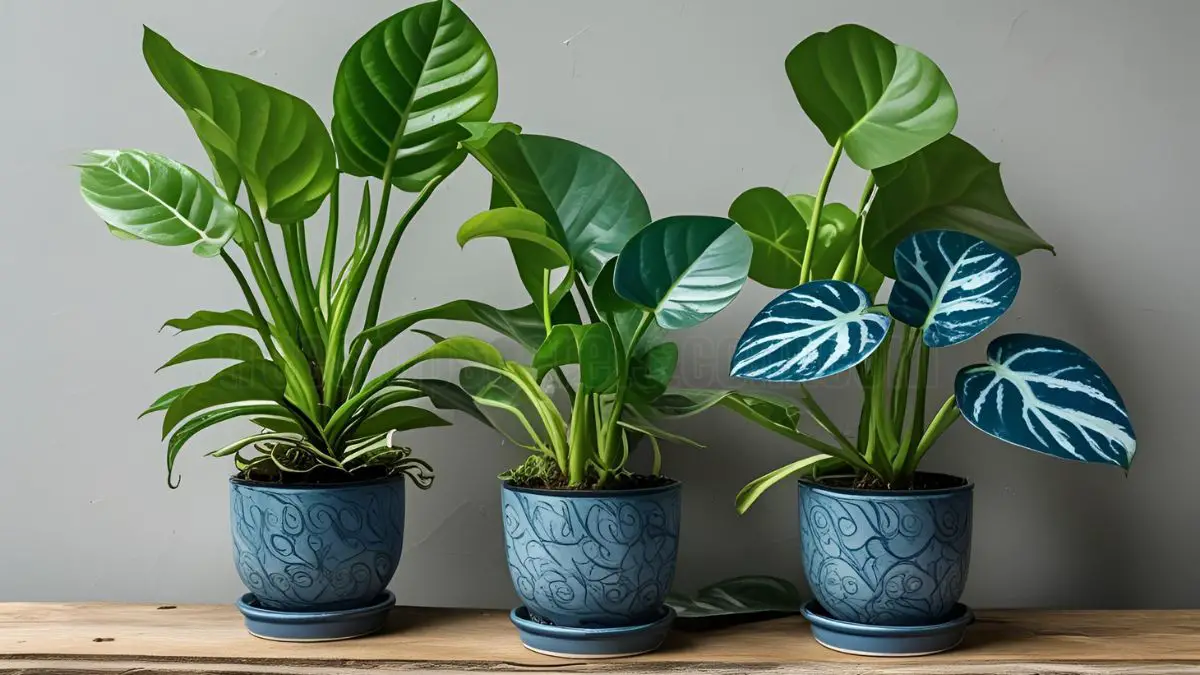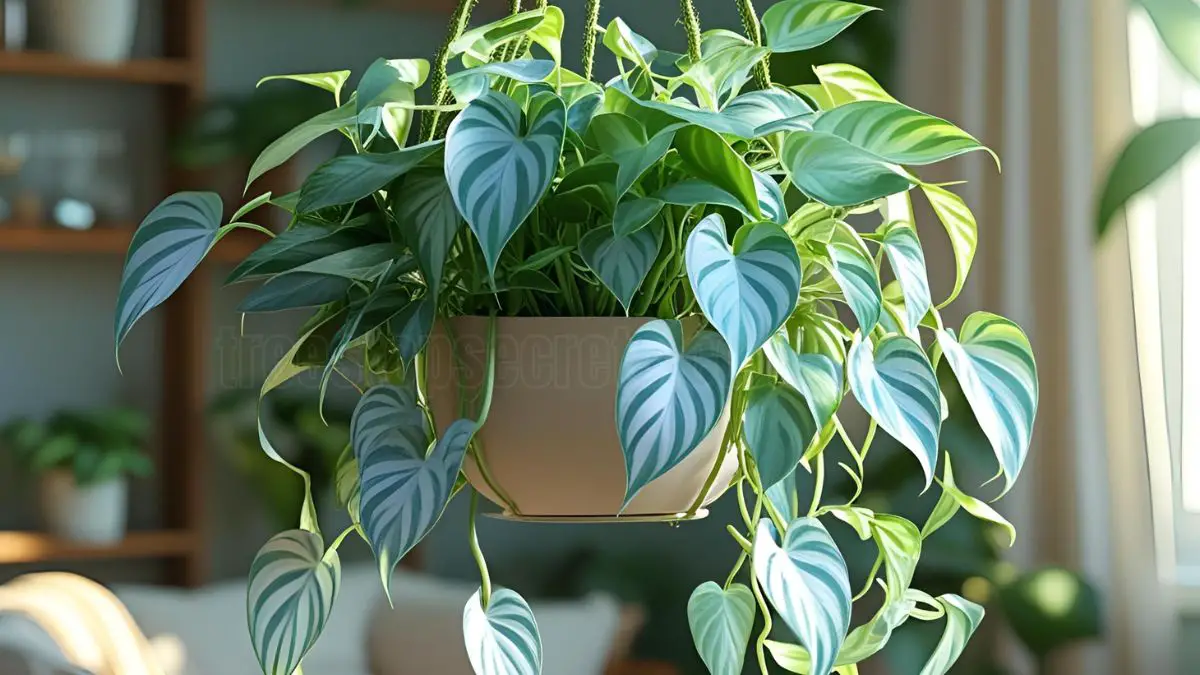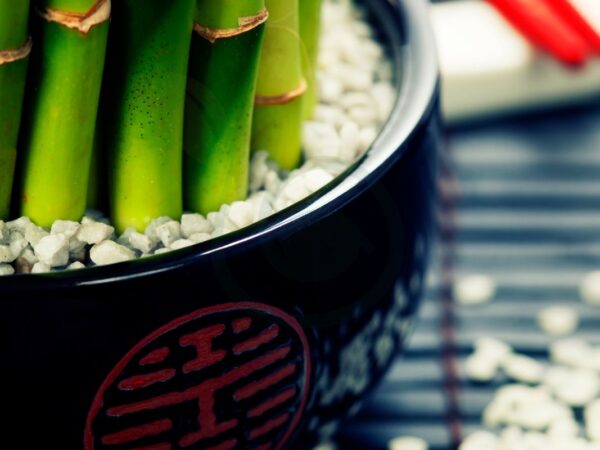Make sure to give this stunning Cebu blue pothos the proper care and environment so it can thrive. Native to the Philippines, this cultivar has beautiful dark bluish-green leaves that add a tropical touch to any home decor.
Cebu blues prefer moderate to bright indirect light. Plant your pothos in a pot with well-draining soil, and water often, allowing the top inch of soil to dry between waterings. Monthly fertilizing during the growing season encourages lush growth and periodic pruning will keep it shapely.
Get these basics down and you’ll be well on your way to creating the ideal habitat for your Cebu blue pothos. This beautiful 5-tetra plant will add beauty to any home or office.
This guide will go further into each area of care to help you become a successful plant parent.
Key Takeaways
- Cebu Blue pothos, known for its striking blue leaves, thrives in tropical conditions and displays climbing traits, making it a versatile choice for indoor decor.
- To keep it thriving, give it medium to bright indirect light. Provide warm conditions, ideally between 60 °F and 90 °F, with humidity levels at least at 70%.
- To avoid overwatering, use the soak-and-dry watering method. It’s best to water your plants every 7 to 14 days, but just watch for wilting or curled leaves to help you determine when to water.
- Choose a potting mix that drains well with a pH range of 6.1 to 7.8. To ensure good aeration and drainage, combine potting soil with perlite or orchid bark.
- Keep an eye out for pests such as mealybugs and scale. Employ organic pest management techniques, like neem oil and beneficial insects, to prevent them from taking over.
- Consistent pruning and upkeep will greatly improve the overall look of the plant. To promote bushier growth, clean off the leaves regularly and watch for any signs of pests.
Understanding Cebu Blue Pothos

As an exotic jewel of the Araceae family, Cebu Blue Pothos is known for its unique blue-toned leaves that set it apart from all other pothos varieties. Its other names, Devil’s Ivy and Dragon-tail, point to the plant’s nature as a climber and its incredible hardiness.
As it is a plant which comes from tropical climates, this greatly impacts the care and environment that it will require.
1. What are Cebu Blue Pothos Characteristics?
Cebu blue pothos foliage can develop a delightful blue hue, which is more pronounced in brighter lighting conditions. Under higher light levels, the foliage develops a more pronounced silvery blue color, making them even more striking.
This is an easy-going, adaptable, flexible grower. Whether climbing towards the light 10 feet up or trailing down from a shelf 5 feet below, Cebu blue pothos is well suited for both residential and commercial environments.
As they grow older, leaves become fenestrated, displaying distinct patterns in the leaf that adds to their visual appeal.
2. Where Does Cebu Blue Pothos Originate?
The Cebu Blue Pothos is a native of the Philippines, thriving in the warm, humid climate of tropical rainforests. This adaptability makes the Cebu Blue plant popular around the world, flourishing in various climates, including its origins in places such as Taiwan and Central America. This resilience and classic beauty make the Cebu Blue pothos a highly desirable choice for indoor gardeners seeking a stunning plant that still makes a statement.
Light and temperature are crucial for the Cebu Blue pothos plant. It thrives best in moderate to bright indirect light, with temperatures ranging from 50-97°F (10-35°C). Consistent moisture is key to ample growth, so it's essential to monitor the conditions for your pothos plants.
Just don’t go overboard with the watering—allow the top 1 to 2 inches of soil in the grow pot to dry out before watering again. While it's not dangerous to touch, the plant is toxic if consumed, so exercising caution when handling is recommended.
Regular pruning in the spring and early fall will help maintain the health and appearance of your mature Cebu Blue pothos. This maintenance plant can flourish beautifully with the right care and attention, making it a favorite among plant lovers.
In summary, the stunning Cebu Blue pothos offers both beauty and resilience, making it an ideal choice for indoor gardens. With proper light, temperature, and moisture management, this tropical beauty can become a centerpiece in your plant collection.
Optimal Growing Conditions

If you want a healthy, happy Cebu Blue pothos, it’s important to recreate the conditions they enjoy in the wild. This beautiful plant loves environments that mimic its native tropical conditions. It requires optimal light conditions, temperature, and humidity in order to thrive.
These are the main factors in providing optimal growing conditions, which are key to healthy growth and beautiful green foliage.
1. Which Light Conditions are Best?
Light conditions that are optimal for Cebu Blue pothos grow best in medium to bright indirect light. It does have some tolerance for lower light conditions, but these increased shade levels usually lead to slower growth and lackluster foliage.
To promote optimal growth, provide the plant with as much bright indirect light as possible while avoiding intense direct sunlight that may burn the leaves. To ensure equal exposure, rotate the plant regularly to encourage growth from all sides.
2. What Temperature and Humidity Levels are Ideal?
The best temperature for Cebu Blue pothos is from 60 °F to 90 °F (16-32 °C). Keeping humidity high at 70% or so works best, as it recreates its natural habitat.
To increase humidity, consider these methods:
- Misting the plant weekly
- Using pebble trays filled with water
- Employing a humidifier in dry conditions
3. How Does Indoor vs. Outdoor Placement Affect Growth?
Specific growing conditions are crucial for indoor plants, so keeping a steady temperature and humidity level is very important. While outdoor placement does offer unique advantages such as abundant natural light and humidity, it can expose growing plants to pests and extreme weather patterns.
Providing shelter from damaging weather conditions is essential to preserving plant wellness.
Watering Practices

Proper watering will do wonders for your Cebu Blue Pothos health. This plant has truly mastered the just-right amount-of-water strategy, because it’s all about the soak-and-dry cycle. This method ensures you’re not overwatering your plants, which can cause root rot — a major killer of both indoor and outdoor plants.
Set up a watering routine of once a week to every other week. Modify this watering schedule according to temperature, humidity and sun exposure.
1. How to Water Cebu Blue Pothos Correctly?
Water the soil well until water begins to escape from the base of the pot. This means your Cebu Blue Pothos will receive just the right amount of moisture. This way, the whole root system is hydrated properly.
Always check the soil moisture before watering. It should be almost dry at least 1 to 2 inches deep. Room temperature water is best. Cold water can shock the plant.
To keep them happiest, water with slightly acidic water with a pH of around 6.0-6.5. If your tap water is extremely alkaline, add a couple drops of vinegar to your watering can to lower the pH.
2. What are Signs of Over- or Underwatering?
Signs of overwatering may involve yellowing leaves and a droopy look. Brown, crispy leaf tips are usually a sign of underwatering or too much direct sun.
Consistently checking the moisture of your soil is critical to avoid underwatering and overwatering. Once moss is laid, mist it weekly as needed to ensure the moss stays evenly moist.
Avoid leaving the soil soggy too; a good quality potting mix with proper drainage is key to avoiding root rot.
Soil and Potting Needs
To encourage optimal growth for your stunning Cebu Blue pothos, it’s important to know their soil and potting requirements. This hardy plant thrives in loose and well-draining soil. Aim to keep the pH in the range of 6.1 to 7.8 to maintain proper nutrient availability and root health.
1. What Soil Mix Supports Cebu Blue Pothos?
To create the best soil mix, use regular potting soil and add perlite or orchid bark. This helps improve drainage and makes it less likely for water to pool. This blend provides excellent drainage for water to escape, minimizing the chances of root rot.
If you want something more natural, consider going with 100% sphagnum moss. It offers superior aeration and moisture retention. Heavy, water-retentive soils should be avoided. They will create issues with roots such as rot and fungal infections.
|
Soil Mix Type |
Drainage Level |
Organic Matter |
pH Level |
|---|---|---|---|
|
Potting Soil + Perlite |
High |
Moderate |
6.1-7.5 |
|
Potting Soil + Orchid Bark |
High |
Moderate |
6.1-7.5 |
|
100% Sphagnum Moss |
Moderate |
High |
6.0-7.0 |
2. How to Choose the Right Potting Medium?
So, when choosing a potting mixture, look for one that will drain excess water but not dry the plant out completely. Less denser mixes promote better root growth, allowing roots to more easily find water and nutrients.
By routinely checking soil moisture, you can be sure your chosen soil medium will continue to be appropriate for plant growth and make changes when needed.
Pest and Disease Management
Keeping the stunning Cebu Blue pothos healthy and thriving starts with proper plant care and treatment of pests and diseases. Consistent monitoring of your pothos plant can significantly mitigate outbreaks and encourage durability. Early detection is critical, as immediate action may be all that’s needed to save this tropical beauty from serious destruction.
1. What Common Pests Affect Cebu Blue Pothos?
Mealybugs and scale are two common pests that can affect Cebu Blue pothos. Mealybugs appear as small white fibrous or cottony blobs. They tend to cluster in leaf axils.
Scale insects, on the other hand, look like tiny brown or black pebbles on stems and leaves. Both issues can cause yellowing foliage and stunted growth. Signs of infestation include sticky residue on leaves, called honeydew, which can attract other pests.
To treat, insecticidal soap or neem oil is usually effective. Apply these remedies directly to the parts infested, making sure to get plenty on there.
2. How to Implement Organic Pest Management Strategies?
Pest populations can be controlled naturally without the use of toxic chemicals. Neem oil is one of the best natural remedies to stop pests before they start, breaking their life cycles and preventing new infestations.
Another method includes releasing beneficial insects like ladybugs that eat the pests naturally. To prevent your Cebu Blue pothos from declining, water your plant properly, give it sufficient light, and feed it the appropriate nutrients.
Healthy plants in the right place are almost never the targets of pest attacks. Preventative measures involve providing adequate airflow around the plant and keeping the growing area clean.
Propagation Techniques
Propagation of Cebu Blue pothos is easy, mainly done through stem cuttings. This technique gives hobbyists the opportunity to grow their collection easily, while promoting strong plant growth. This is why rooting cuttings in water before planting them in soil is such a widely advocated technique.
This technique helps you to monitor root development and gives the cuttings a more controlled environment to flourish.
1. How to Propagate Cebu Blue Pothos Successfully?
To begin, choose healthy stem cuttings, making sure each cutting has at least one node. This node is very important for root formation. Once you’ve snipped your stems, place them in a glass of water.
Ensure that the node is fully under water, but don’t allow the leaves to sit under the water. Replace the water every few days to keep it clean and oxygenated, encouraging healthy, strong roots to form. When the new roots reach 2-3 inches long, transfer the cuttings into a well-draining potting mix.
This will provide them with the best conditions to flourish and grow even more.
2. What are Tips for Ensuring Healthy Offspring?
Bright, indirect light will help while in the rooting phase. It encourages vigorous growth and propels the cuttings into a better acclimatization. Maintaining lightly moist soil—not wet—allows the roots to form without becoming rotten.
Keeping a close eye on humidity levels is important. Fit a humidity dome over your cuttings or use a spray bottle to maintain the perfect amount of moisture.
Fertilization and Nutrient Needs
Fertilization is one of the most important factors in keeping your Cebu Blue plant healthy. Consistent fertilization during its active growing season—spring and summer—promotes lush development of this stunning Cebu Blue pothos. A balanced liquid fertilizer, applied monthly, nourishes the plant and encourages abundant green foliage.
1. Which Fertilizers are Most Effective?
Balanced liquid fertilizers, such as 10-10-10 or 20-20-20, work wonderfully on Cebu Blue pothos, providing nitrogen, phosphorus, and potassium in equal proportions. These nutrients are essential for plant vigor, root growth, and shoot/leaf development.
Examples of organic fertilizers include fish emulsion and compost tea, both of which help plants grow faster than without added nutrients. They accomplish this all without the danger of chemical accumulation.
It’s very important to avoid over-fertilization. Overapplication of nutrients can result in nutrient burn, resulting in curling, yellowing leaves, and stunted growth.
|
Advantages |
||
|---|---|---|
|
Balanced Liquid |
N-P-K 10-10-10 |
Promotes overall growth |
|
Fish Emulsion |
N-P-K 5-1-1 |
Organic, boosts root health |
|
Compost Tea |
Varies |
Enhances soil microbiome |
2. How to Establish a Nutrient Regime for Growth?
Developing an appropriate fertilization schedule is essential to providing nutrients when the plant needs them in conjunction with its growth cycle. Begin with monthly applications while the plant is actively growing and increase or decrease according to the plants’ response.
Keep track of soil quality and nutrient levels. This will allow you to better customize your approach and provide your Cebu Blue pothos with the care it deserves.
Consistent monitoring will allow you to adjust your fertilization program accordingly, keeping your plants healthy and growing to their full potential.
Maintenance and Pruning Tips
Routine care and pruning will ensure your Cebu Blue Pothos stays healthy and attractive. This process will make the plant more aesthetically pleasing and create bushier growth making the plant fuller.
Make the majority of your cuts during the active growing period, typically late spring and summer. This timing allows them to bounce back with vigor and look magnificent.
1. How to Prune for Optimal Health?
Start by cutting out the leggiest vines and dead foliage. This process allows them to create denser, bushier growth and makes the plant look healthier and more attractive.
When cutting, always trim just above a node. This technique encourages new growth from the cut stem and helps make your plant fuller. It’s important to not skip this step—scissors or hand pruners should be clean enough to prevent the spread of diseases.
2. What Maintenance Practices Enhance Appearance?
Clean the leaves frequently to get rid of dust so they can do more photosynthesis and stay healthy. It only takes a gentle wipe with a damp cloth to improve your plant’s well-being and appearance dramatically.
Rotating the plant every few weeks will help make sure that all parts of the plant are getting adequate light, which is important to a healthy, balanced plant. Lastly, consider pests and diseases, because early detection is critical for keeping plants healthy.
Tools Needed for Effective Pruning:
- Clean scissors or shears
- Sterilizing solution (e.g., rubbing alcohol)
- Soft cloth for cleaning leaves
Recognizing Stress and Nutrient Deficiencies
This knowledge is important to keep your stunning Cebu Blue Pothos happy and thriving. With early recognition, you can avoid irreparable damage and help your tropical beauty flourish in its home.
1. What are Early Signs of Stress in Cebu Blue Pothos?
Early signs of stress such as curling, wilting, or drooping leaves usually mean that your plant is not taking up enough water or nutrients. Discoloration is one of the most important signs to look out for.
Yellow leaves usually equal overwatering or nutrient deficiency. Browning leaf tips equal underwatering or salt buildup. These symptoms should be addressed as soon as possible to avoid further deterioration.
2. How to Remedy Environmental Imbalances?
Changing your watering habits is important, especially if you see signs of leaf yellowing. Keep soils well-drained to avoid excessive moisture that can lead to or aggravate nutrient deficiencies.
If your plant is looking leggy or the leaves are starting to pale, you might need to improve your lighting situation. A Cebu Blue Pothos will do best in bright, indirect light, so try moving it to a brighter spot if it’s having a hard time.
Finally, proper humidity and temperature levels are important during recovery, since any variations can put the plant under additional stress.
Common Nutrient Deficiencies and Symptoms
- Nitrogen: Yellowing leaves, especially older ones.
- Phosphorus: Dark green or purplish leaves with slow growth.
- Potassium: Browning leaf edges and weak stems.
- Magnesium: Interveinal chlorosis, where leaf veins remain green while the surrounding tissue turns yellow.
Conclusion
When provided with the proper care, Cebu Blue Pothos is a rewarding and beautiful plant. As for cebu blue pothos light and soil requirements, prioritize bright, indirect light and well-draining soil. Water when the top inch of soil becomes dry, and watch for pests, especially spider mites. Regardless, regular pruning will keep your plant healthy and help it grow more vigorously. If leaves start turning yellow, re-evaluate your watering schedule and/or nutrient strength.
Cebu Blue Pothos is an excellent addition for new and advanced plant enthusiasts alike. When cared for, it adds vibrant beauty and refreshing air-cleaning qualities to any interior. Embrace the journey of plant parenthood, and reap the satisfaction that comes from successfully caring for your Cebu Blue Pothos. Begin your adventure today and see your green companion thrive!
Frequently Asked Questions
What is Cebu Blue Pothos?
Cebu Blue Pothos, also known as Pothos ‘Cebu Blue’, is a stunning plant celebrated for its uniquely shaped silvery-blue foliage. This popular houseplant has become a favorite among indoor gardeners due to its striking color and low-maintenance plant care.
How much light does Cebu Blue Pothos need?
This stunning Cebu blue pothos plant does best in bright, indirect light. Direct sunlight will burn the leaves, but if conditions are too dim, the mature Cebu blue pothos will grow poorly.
How often should I water Cebu Blue Pothos?
Water your Cebu Blue plant when the first inch of soil is dry to the touch, typically every 1-2 weeks, depending on your humidity and temperatures for optimal plant care.
What type of soil is best for Cebu Blue Pothos?
Choose a loose, well-draining potting soil mixed with perlite or orchid bark for aeration, which is essential for the health of your pothos plants.
How do I propagate Cebu Blue Pothos?
The easiest way to propagate the stunning Cebu Blue Pothos is by taking stem cuttings with a minimum of one node. Keep the cuttings in either water or soil until this hardy plant forms roots.
What pests should I watch for on Cebu Blue Pothos?
Common pests that might attack your stunning Cebu Blue Pothos include spider mites and mealybugs. Monitor your plant closely and target infestations quickly with insecticidal soap or neem oil for effective plant care.
How do I know if my Cebu Blue Pothos is stressed?
Signs of stress in your Cebu blue plant include yellowing leaves, wilting, and stunted growth. To help your stunning Cebu blue pothos thrive, ensure you’re not overwatering, providing adequate light, or dealing with a pest problem.
Image Source: Paid image from CANVA



